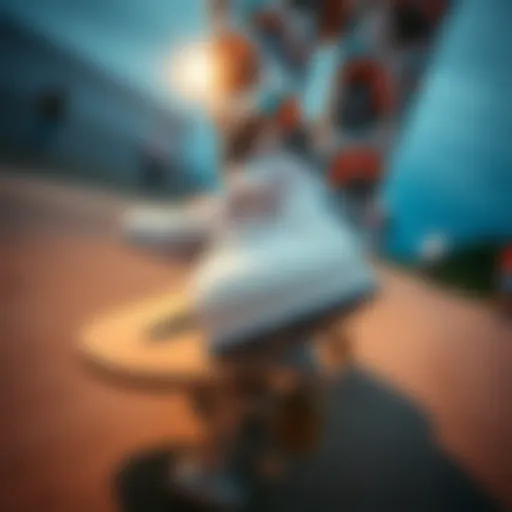The Creative Potential of Blank Skateboard Decks
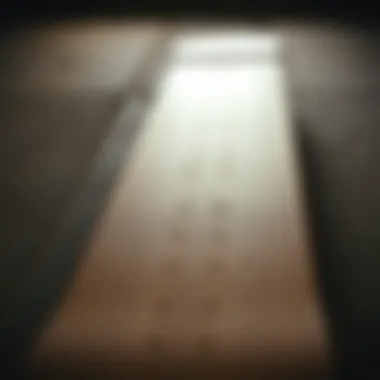
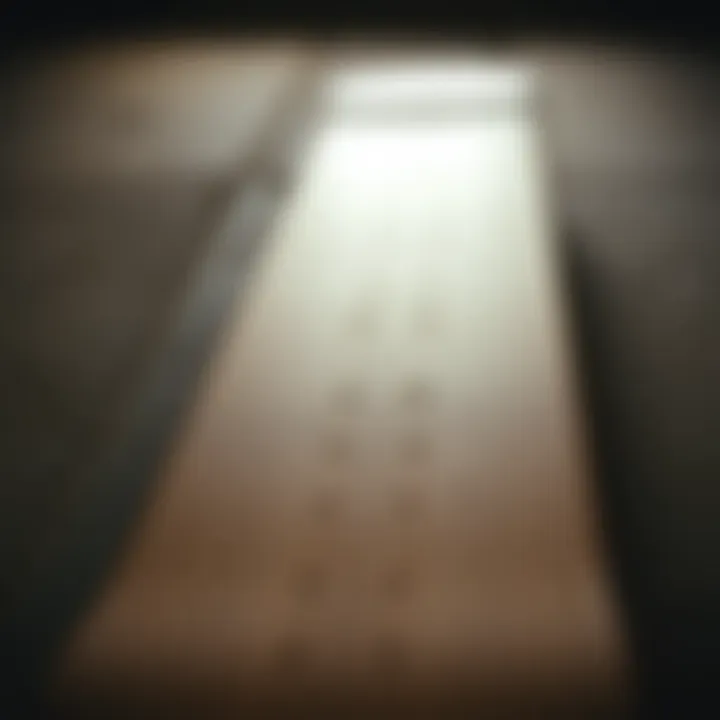
Intro
In the vibrant world of skateboarding, the blank skateboard deck stands as an emblem of personal expression and creativity. Unlike pre-designed boards adorned with flashy graphics, blank decks offer a unique opportunity for skaters to transform a simple piece of wood into a personalized masterpiece. This element of individuality is particularly significant in skate culture, where the community thrives on self-expression and innovation.
When one considers the role of the blank skateboard deck, it becomes evident that it transcends mere utility; it embodies a canvas waiting for the touch of creativity. From novice skaters looking to make their first mark to seasoned riders eager to showcase their artistry, these unmarked boards hold endless possibilities. The allure of a blank deck lies not only in its potential for customization but also in the narratives that are embedded into every scratch or design.
Blank decks are essential in promoting the idea that skateboarding is not just about tricks and stunts, but also about creating one's identity. As such, delving deeper into the dimensions of blank skateboard decks can uncover insights into the heart of skating culture, revealing how these simple boards connect to broader themes of expression and individuality.
With this in mind, let's explore the various aspects surrounding blank skateboard decks, focusing on their significance in skateboarding culture.
Understanding the Blank Skateboard Deck
Understanding the blank skateboard deck is essential for not only skaters but also for artists and creatives within the skate culture. A blank deck is more than just a piece of wood; it’s a foundation for personal expression, a tool for creativity, and, in many cases, a canvas waiting for the artist’s touch. Exploring this subject gives insight into how one can fully embrace their identity while skating. Blank decks offer endless possibilities, from modest decals to bold masterpieces that turn a skate deck into a statement piece.
Definition of a Blank Skateboard Deck
A blank skateboard deck can be described simply as an unadorned board without any graphics or designs. It typically consists of a maple wood construction, known for its durability and strength, essential qualities for any skateboard. Blanks come in various sizes, accommodating different skating styles and preferences. For skateboarders, this lack of visual flair invites individual interpretation. Rather than a commercially produced graphic that the broader public recognizes, a blank deck prompts the wearer to make it their own. This minimalist approach suits those who appreciate the understated elegance of clean lines and the potential for personalization.
History and Evolution
Delving into the history of blank skateboard decks reveals fascinating layers of transformation over the decades. In the earlier days of skateboarding, the decks didn't boast flashy designs; most were often left blank as riders simply focused on the fundamentals of skating. As the culture grew in the 1970s and 1980s, the aesthetic shifted dramatically. Companies began pouring resources into elaborate graphics and branded designs, hoping to gain traction in an increasingly competitive market.
However, as the counter-culture developed, so did the desire for unique identities. Skaters gravitated back to the simplicity of blank decks, finding a sense of freedom in their bare essence that allowed personal expression to shine through. This shift led to a renaissance—an evolution where artists began to view the blank skateboard deck as canvases, ultimately blurring the lines between skating and art.
Today, the blank skateboard deck serves as a reminder of the roots of skate culture—a return to the promise of individuality and the creative spirit that propelled the movement initially. Whether it’s used for a skateboard trick or as a statement piece in a gallery, the blank deck continues to symbolize the unyielding drive for personal expression in a world saturated with noise.
"A blank skateboard deck is more than just wood; it's the blank page of the artist's diary, each stroke and design tells a unique story."
Through this lens, it becomes clear why understanding a blank skateboard deck is crucial. It encompasses the essence of creativity, personal style, and a deeper connection to the skateboarding community.
Materials and Construction
Understanding the materials and construction of a blank skateboard deck is crucial for anyone interested in skateboarding. The deck serves as the primary platform for the rider, affecting everything from performance to durability. Skateboard enthusiasts ought to realize that not all decks are created equal. Constructed from various materials and shaped into numerous designs, the choice ultimately impacts the way skaters express themselves and maneuver.
Types of Wood Used
Most skateboard decks are made from a wood known as 7-ply maple, providing a robust foundation for riders. Maple is particularly admired for its ability to handle stress and impacts while also maintaining a light weight. Plywood, consisting of multiple layers glued together, allows for flex and strength, giving riders the necessary support and responsiveness.
Some manufacturers also use alternative woods like birch or bamboo. Birch decks are slightly harder and can offer excellent pop, while bamboo tends to be lighter and highly flexible. Here are a few key points when considering wood types:
- Maple: Known for durability, balance between flexibility and stiffness.
- Birch: Provides good pop and feels solid underfoot.
- Bamboo: Light, eco-friendly, and extremely flexible.
Each type of wood offers a distinct feel and performance level, so choosing the right one is all about personal preference and skating style.
Deck Shape and Size Variations
Deck shape and size are not just box-ticking exercises; they play a significant role in how the skateboard performs. Shapes vary from wide and flat to narrow with pronounced kicktails, affecting tricks and comfort. For instance, decks with a wider stance allow for more stability, making them ideal for beginners, while narrower decks are often preferred by those who lean toward technical tricks.
The length of the deck also plays a vital role. Shorter boards provide agility for street skating, while longer boards offer stability for cruising or downhill riding. Here are some factors to keep in mind:
- Nose and Tail: A pointed nose and tail can enable easier flip tricks,
- Concave Depth: A deeper concave aids in foot placement for tricks.
- Width: Consider your foot size; wider boards offer more room, while narrower decks cater to technical maneuvers.
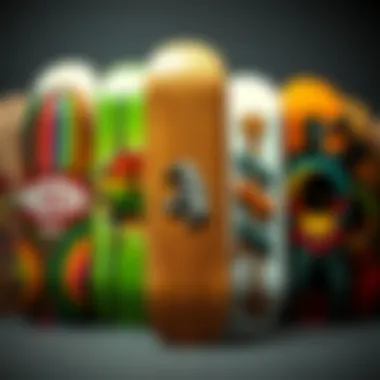
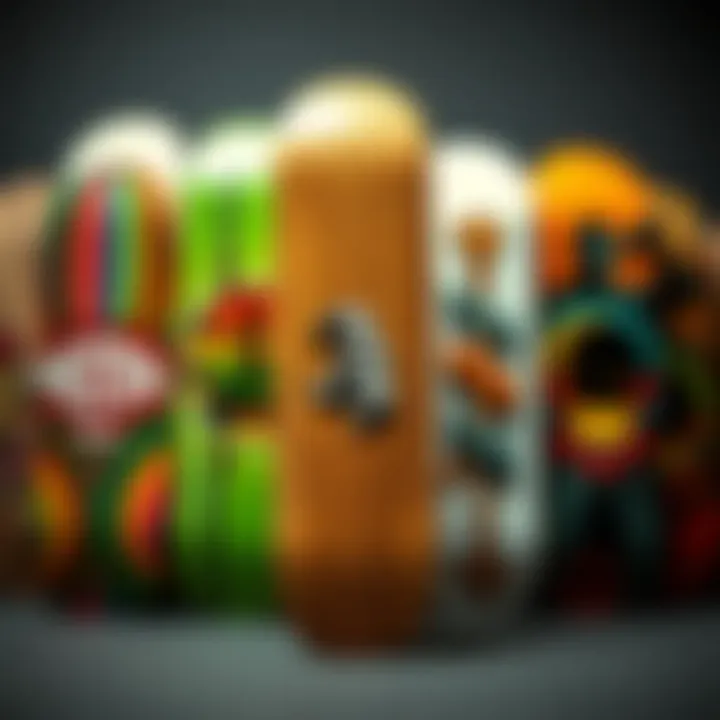
To put things into perspective, a wider nose might be more forgiving if you're still getting the hang of landing tricks. Meanwhile, a steeper tail could serve a seasoned skater well for getting that extra height on Ollies.
In summary, the materials and construction of a blank skateboard deck significantly influence not only performance but also the rider's personal expression on the board. Selecting the right type of wood and understanding how shape and size impact riding experience turns a simple plank into a conduit for creativity. It’s not just about riding; it’s about how you connect with the motion, the art, and the culture of skateboarding.
The Aesthetic Appeal of Blank Decks
Blank skateboard decks don't just serve as tools for riding; they embody a unique aesthetic that resonates deeply with skateboard culture. This appeal comes from a blend of minimalism and the boundless possibilities for personalization. For many skaters, a blank deck represents a starting point of creativity and self-expression, allowing individuals to showcase their identity and artistic skills.
Minimalism in Skateboarding
In today's fast-paced world, the minimalist trend has taken hold in various domains, including skateboarding. Blank decks epitomize this idea, offering a clean slate devoid of distractions. The simplicity resonates well with skaters who appreciate understated style. Rather than flashy graphics or logos, blank decks allow the board's shape and wood grain to shine through.
This minimalistic approach serves several benefits:
- Focus on Performance: Without the weight of graphic designs, a blank deck can be lighter and often more agile.
- Timelessness: Minimalism tends to age well. It doesn't fall prey to gaps in trends; a blank deck looks just as appealing now as it will years down the line.
- Broad Appeal: Whether you’re a beginner or a seasoned pro, a blank deck suits any skateboarding style, from street skating to vert.
Personal Customization Possibilities
Personalization is where the beauty of a blank skateboard deck truly shines. From the moment a skater acquires a plain deck, the options for customization spark a flurry of ideas and projects. The thrill of transforming a blank canvas into something unique is not just about creativity; it's about self-expression.
Painting Techniques
One popular method of customization involves painting. Custom painting allows skateboarders to express their individuality vividly and colorfully. Skaters can use various types of paint—such as acrylic, spray paint, or even markers—to create intricate designs or simple patterns.
Key characteristics of painting techniques include:
- Flexibility: Artists can use gradients, stencils, or freehand styles, leading to a diverse aesthetic.
- Durability: Using appropriate sealants makes painted designs resilient to wear and tear.
While painting can be a popular choice for many, it requires a certain level of skill. Mistakes can be hard to fix without professional help, and a poorly executed design could deter from the overall appeal of the deck.
Graphic Decals
Graphic decals hold another special place in skateboard customizations. Unlike painting, decals offer quicker application with often striking visuals. High-quality vinyl decals can provide a professional look without the learning curve associated with painting. This ease of use makes decals appealing for those looking to quickly personalize their boards without an artistic background.
Unique features of graphic decals include:
- Variety: From popular culture icons to original artwork, the options are vast.
- Easy Removal: If a design doesn't meet expectations, decals can be removed and replaced with little hassle.
However, one potential downside is that decals might not adhere well under extreme conditions, potentially peeling off over time.
Stickers and Add-ons
Stickers represent perhaps the most straightforward means of deck customization. These easily accessible items come in all shapes, sizes, and themes. The beauty of stickers lies in their ability to express what a skater likes, whether it’s pop culture references, social causes, or simply fun graphics.
Key characteristics of stickers and add-ons include:
- Accessibility: Easily found at skateboard shops or online, they present low entry barriers for personalization.
- Layering: Stickers can be layered in creative ways to craft a one-of-a-kind look.
Nevertheless, the challenge with stickers is ensuring they are weather-resistant and won’t fade with time. It can be a bit tricky to light up a board without making it feel cluttered. Thus, careful selection is needed to maintain balance and harmony in the design.
Blank Decks and Personal Expression


When you consider the world of skateboarding, it’s easy to see that it’s much more than just a sport. It's a culture, a lifestyle that emphasizes freedom and creativity, and at the core of this culture is the blank skateboard deck. Blank decks serve as a vital platform for personal expression. They’re not just about tricks and flips; they’re about what you want to say to the world. Every scratch, every paint stroke, tells a story that’s uniquely yours.
With a blank deck, skaters have the opportunity to showcase their individuality in a way that’s visible for all to see. Whether through colorful designs, intricate artwork, or even just a simple phrase, these boards transform into canvases that represent personal beliefs, experiences, and artistic inclinations. This not only allows for a deeper connection with the board itself but also cultivates a sense of ownership, turning a generic piece of equipment into something profoundly personal.
Beyond just aesthetics, customizing a blank skateboard deck also taps into one’s creativity— the practice of skateboard art fosters skills like painting, drawing, and even graphic design. Enthusiasts of all ages can experiment with different materials, from acrylic paints to spray paints, or even turn to digital methods to create stickers or wraps. Thus, expressing oneself through a blank skateboard deck can also lead to the development of new skills and the discovery of hidden talents.
Skateboard Art and Individuality
In the realm of skateboarding, art finds its truest form on the blank deck. This is where individuality shines the brightest. A blank skateboard deck is a sanctuary for self-expression; it’s an invitation to paint your world in your own colors. Consider a local skater, who spends hours crafting a design that vividly captures their personal journey. It’s not just about aesthetics—it’s a declaration of who they are and what they represent.
From graffiti-style bombardments to minimalist designs, there are countless forms of art that can be displayed on skateboard decks. Here are some examples of common themes:
- Personal experiences: Many opt to showcase important life events or milestones, making their board a tribute to their journey.
- Social messages: Others may choose to express political views or social justice themes, enabling them to communicate important messages through their skating.
- Cultural influence: Decks can also reflect cultural backgrounds, incorporating elements that resonate with one’s heritage.
The vast freedom associated with decorating a blank deck leads to innovative and distinct expressions that challenge traditional skateboarding norms. As the famous skateboarder Tony Hawk once said, "Skating is a very personal thing, and the boards should reflect that."
Community Bonds Through Customization
The act of personalizing a blank skateboard creates not only individual expressions but also fosters community bonds. Skaters often share tips and ideas about customization through forums or local skate parks, where they exchange techniques and inspiration. The connection that comes from this mutual exchange transforms simple customization into a collaborative form of art.
Furthermore, customized decks often become conversation starters or even showcases of collaboration. Skaters might come together for events where custom decks are the centerpiece. Consider a local skate competition where participants not only show off their skills but also their uniquely designed boards. This shared experience strengthens camaraderie among skaters, building networks and friendships that span across different regions and backgrounds.
The act of personalizing a skateboard embodies the essence of community in skate culture. It’s a collective celebration of creativity. Whether one is throwing paint around at a workshop or sharing a laugh over a new deck design, these moments reinforce the bonds we share through our shared passion.
Through blank skateboard decks, individuality is honored, and community ties are strengthened, making every ride more than just a sport—it's a celebration of life itself.
Performance Aspects of Blank Skateboard Decks
Understanding the performance aspects of blank skateboard decks is crucial for anyone involved in the sport. It not only determines how well a skateboard performs under different conditions but also how it caters to the unique style and techniques of individual skaters. Performance encompasses several elements—primarily quality and durability—that can significantly influence a skating experience. When selecting a skateboard deck, these attributes can determine whether a ride feels natural or if it just doesn’t cut the mustard.
Quality and Durability
Quality and durability of a blank skateboard deck are paramount. When it comes to materials, not all wood is cut from the same cloth. Most reputable decks are constructed from maple wood, known for its strength and flexibility. This specific type of wood tends to hold up well against the wear and tear of tricks and flips. On the other hand, lower-quality boards made from inexpensive wood can warp or break after a short period, leading to frustrations on the pavement.
An important factor in durability is the construction technique. Blank decks typically undergo a process called pressing, which involves layering multiple sheets of wood. The number of layers—often referred to as plies—can affect the strength. A higher ply count (usually between seven to nine) results in a sturdier board, able to withstand greater pressure and abuse during tricks that require a lot of vertical lift.
"The real test of a skateboard deck’s quality is not just its appearance, but how it holds up after a season of intense use."
In addition to the material and construction, other considerations like finish contribute to a board's longevity. A well-coated deck not only resists scratches but also protects against moisture. Skaters who ride in varying climates should choose options that are treated for added resilience.
Impact on Skateboarding Techniques
The impact of deck performance on skating techniques cannot be understated. The feel of a board directly influences how skaters execute their tricks. A stiff deck is generally preferred for precise, technical tricks like flips, while a more flexible deck allows for a smoother ride over rough surfaces.
When a skater feels comfortable with their deck's responsiveness, it can lead to improved performance. For instance, when landing tricks, skaters need a board that absorbs impact rather than just jolting back, which could lead to loss of control and potential injuries.
Moreover, differences in deck shape can impact skateboarding style. A deck with a wider nose and tail can facilitate easier landings, whereas a tapered deck might contribute to a more agile experience for technical tricks. Skaters are constantly experimenting with these variables, making it imperative to find a blank deck that aligns with their personal skating goals.
Market Trends in Blank Skateboard Decks
The world of skateboarding is constantly evolving, and observing the market trends in blank skateboard decks offers valuable insights into the preferences and behaviors of skaters today. Blank decks are more than just a piece of wood used for riding; they are a reflection of individual creativity and community identity. Understanding these trends is essential because it informs retailers, manufacturers, and even novice skaters about what’s rocking the boarding scene.
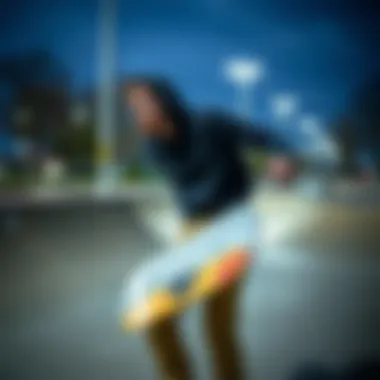
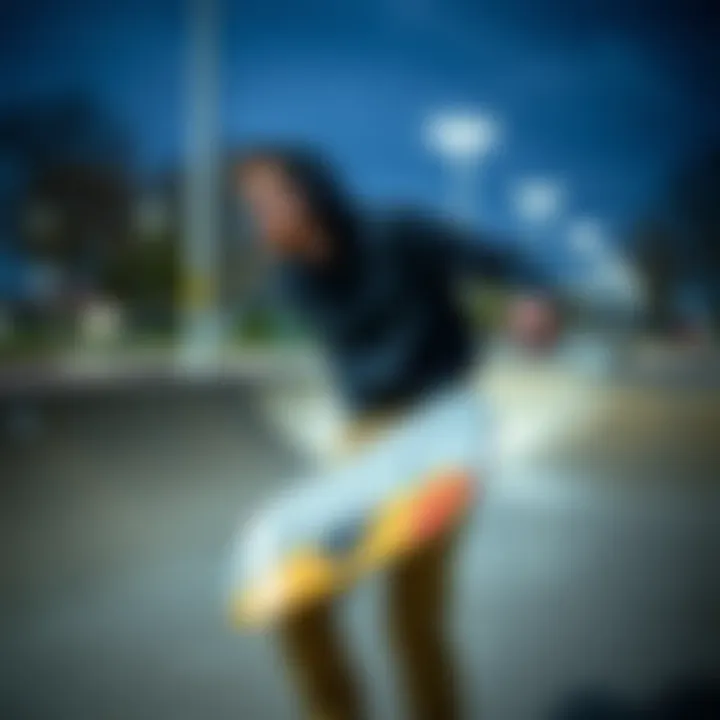
Popularity Among Different Demographics
When we take a close look at who’s buying blank skateboard decks, it becomes crystal clear that they appeal to a wide range of demographics. This popularity spans ages, from young kids to seasoned skaters, and even includes parents purchasing for their kids. The simplicity and versatility of blank decks make them suitable for individuals who appreciate minimalism as well as those eager to unleash their artistic flair.
Interviews and surveys have shown that the following demographics are particularly drawn to blank skateboard decks:
- Young Children: Parents often opt for blank decks as an introduction to skateboarding, allowing kids to design their own boards. This gives children a personal stake in their hobby from the get-go.
- Teenagers and Young Adults: Skaters in this age group often view blank decks as a personal canvas for expression, fostering creativity through customization. They relish the opportunity to showcase their individuality through unique designs.
- Older Skateboarders: Some veteran skaters prefer blank decks for their performance characteristics, often pairing them with their custom graphics. They appreciate the flexibility a blank deck provides for putting their spin on what skateboarding means to them.
The surge in interest can be attributed to social media platforms like Instagram and TikTok, where skaters showcase their custom creations, further igniting discussion and enthusiasm around blank decks.
Comparative Analysis of Brand Offerings
In the marketplace, different brands offer a myriad of blank skateboard deck options, each with its strengths and weaknesses. Knowing how to compare these offerings is crucial, especially for buyers looking to make an informed decision. Let’s break down some key differences:
- Material Quality: Not all decks are created equal; some brands like Santa Cruz or Element utilize higher-grade wood, which can lead to increased durability and performance. However, lesser-known brands might offer competitive pricing coupled with decent quality.
- Shape Variations: While many brands stick to standard shapes, others provide unique cut styles catering to specific tricks or riding styles. This can be a deciding factor for skaters who have specific preferences.
- Cost Considerations: Brand reputation often dictates price. High-end brands tend to charge a premium, but it might be beneficial to compare with emerging brands that offer similar quality without the hefty price tag.
When assessing brands, it’s good to look for independent reviews and feedback on platforms like Reddit or skateboarding forums. This gives a clearer picture of real-world performance and usability from fellow skaters.
"A blank skateboard deck is not just a tool; it's a piece of your identity on wheels."
To sum up, the trends in blank skateboard decks reflect an intriguing blend of individualism and community spirit, showcasing how skaters place value on personal expression and quality in their equipment. By keeping an eye on who’s buying and how the various brands compare, we can better understand the direction in which skateboarding culture is heading.
Practical Tips for Choosing a Blank Deck
Choosing a blank skateboard deck is not just about picking out a piece of wood; it’s about finding the right canvas for your creativity. A well-selected blank deck can significantly impact not only your skateboarding experience but also your ability to express yourself through design and style. Here, we’ll explore the key factors to consider when making this essential choice, helping you to align your skill level, preferences, and budget with what the market has to offer.
Assessing Skill Level and Preferences
When selecting a blank skateboard for the first time, one might think it’s merely a matter of taste. However, understanding your skill level and preferences is crucial.
- Beginner skaters should opt for decks that have more flex and stability. A wider board might be a better fit, as it offers balance while you master the basic tricks. For instance, decks around 8.0 inches wide could provide just the right surface area to build confidence.
- Intermediate and advanced skaters, on the other hand, often prefer more responsive decks that offer a stiffer feel, which translates into better performance during jumps and tricks. Look for narrower options, typically around 7.5 to 7.75 inches wide, to gain agility.
Your personal style also plays a part. If you lean towards street skating, a lighter deck could benefit tricks that need a quick pop. If you enjoy cruising or vert, a sturdier board with more weight may work in your favor. Some skaters even enjoy experimenting with different shapes, so it might be worth trying out a few decks before settling on a final decision.
"Choosing a deck that aligns with your skill doesn’t just enhance your performance, it also enriches your journey into skating."
Budget Considerations
Budget is often a significant factor when choosing a blank deck, but approaching it doesn’t have to be daunting. Keep in mind that investing in a quality deck can pay dividends in both performance and creative expression.
- Affordable Options: Many beginners find success with budget-friendly brands. These decks can be decent quality while also providing an opportunity to explore customization without a hefty investment. Brands like Element, Blind, and Baker often offer blanks at reasonable prices, especially for first-time skaters.
- Premium Choices: On the other end, if you have the resources, consider investing in higher-end decks made from specialized materials or with unique characteristics. Brands like Almost and Anti-Hero may charge more, but their durability and the performance can be worth it in the long run.
Additionally, remember the cost of customization. Whether you're painting, applying stickers, or using graphic decals, there may be additional expenses involved. Prioritize your budget and consider how much you want to invest in your creative journey.
Look for sales or second-hand options, too. Often, skaters trade or sell decks they've used, and you can score a great deal. Ultimately, whatever your budget, there are countless blank deck options available that can suit your needs while allowing plenty of room for personal expression.
End: Embracing Creativity on Blank Decks
As we wrap up our discussion, it’s quite apparent that blank skateboard decks represent more than mere pieces of wood; they are blank slates that invite creativity to take center stage. One can argue that these decks embody the true spirit of skateboarding, aligning closely with the culture's roots in self-expression and individuality. They give skateboarders, whether seasoned pros or beginners, an opportunity to toss aside the commercialism often associated with branded designs and instead foster a personal connection with their gear.
The Future of Blank Skateboard Decks
Looking ahead, the landscape of blank skateboard decks appears ripe with potential. There’s a growing trend among skaters who seek to customize their boards not only to stand out in a crowd but also to articulate their unique stories and styles. This inclination towards personalization is likely to accelerate as more artists and designers enter the space, introducing fresh techniques and ideas that will inspire even more creativity.
- Sustainability: As awareness of environmental issues increases, we might see a shift towards using sustainable materials in the production of blank decks. Manufacturers focused on eco-friendly practices may capture the attention of conscientious skaters.
- Technological Integration: Innovations such as augmented reality could soon allow skaters to visualize their designs digitally before committing to a permanent paint job or decal application.
- Community-Driven Designs: Social media platforms like Reddit and Instagram are already fostering collaborations within the skate community. Future collaborations among skaters, artists, and brands may lead to a new wave of popular designs, stemming from sheer creativity and collective effort.
Ultimately, embracing creativity on blank skateboard decks is not just a trend—it's a powerful movement reflecting the evolution of the skateboarding culture. Skateboarders and artists alike have the opportunity to shape not only their own identities but also the very fabric of this sport. As these blank canvases continue to dominate, their potential will not only remain relevant but thrive in a rapidly transforming world of skateboarding.





